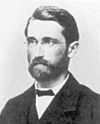Ring (mathematics) facts for kids
In mathematics, a ring is an algebraic structure consisting of a set together with two operations: addition (+) and multiplication (•). These two operations must follow special rules to work together in a ring.
Mathematicians use the word "ring" this way because a mathematician named David Hilbert used the German word Zahlring to describe something he was writing about. The integers, the rational numbers, the real numbers and the complex numbers are all famous examples of rings. There are other, more unusual examples of rings, however they all obey the special rules below.
Rules
The operations are used to combine two elements to form a third element. There are a few rules the set and the operations must obey to qualify as a ring. These are called ring axioms:
- Closure: It is required to check if the suggested operations are actually operations on the set. If an operation is used on any elements in the ring, the element that is formed will also be part of the ring.
- For all a, b in R, the result of the operation a + b is also in R.
- For all a, b in R, the result of the operation a • b is also in R.
- Additive Identity element: One element of the ring is special. It is called the additive identity element. If addition is used with the identity element and another element, the other element will not change.
- There exists an element 0 in R, such that for all elements a in R, the equation 0 + a = a + 0 = a holds.
- Associativity of Addition: When addition is done many times, it does not matter how it is grouped, the result will be the same.
- For all a, b and c in R, the equation (a + b) + c = a + (b + c) holds.
- Commutativity of Addition: When addition is done, it does not matter which element is on the right and left, the result will be the same.
- For all a and b in R, the equation a + b = b + a holds.
- Additive Inverse element: Every element in the ring has another element in the group when addition is performed between them, the result is the additive identity element. This is known as its additive inverse.
- For each a in R, there exists an element -a in R such that a + (-a) = 0, where 0 is the additive identity element.
- Associativity of multiplication: When multiplication is done many times, it does not matter how it is grouped, the result will be the same.
- For all a, b and c in R, the equation (a • b) • c = a • (b • c) holds.
- Distribution: When multiplication and addition are both done, certain rules apply.
- For all a, b and c in R, the equation (a + b) • c = (a • c) + (b • c) holds.
- For all a, b and c in R, the equation a • (b + c) = (a • b) + (a • c) holds.
Special Kinds of Rings
Some rings have additional properties from those mentioned above, these rings get special names:
Commutative Ring If x • y = y • x holds for every x and y in the ring, then the ring is called a commutative ring.
Ring with Unity If there is a multiplicative identity element, that is an element e such that for all elements a in R, the equation e • a = a • e = a holds, then the ring is called a ring with unity. This element is usually written as 1.
Division Ring If every element of the ring has a multiplicative inverse, that is for each a in R, there exists an element a-1 in R such that a • a-1 = 1, where 1 is the multiplicative identity element, then the ring is called a division ring.
Integral Domain In a ring, it may be possible to multiply two things which are not zero and get zero as a result. If this is impossible in a certain ring, then the ring is called an integral domain.
Field A ring with all of the above properties is called a field.
See also
 In Spanish: Anillo (matemática) para niños
In Spanish: Anillo (matemática) para niños


